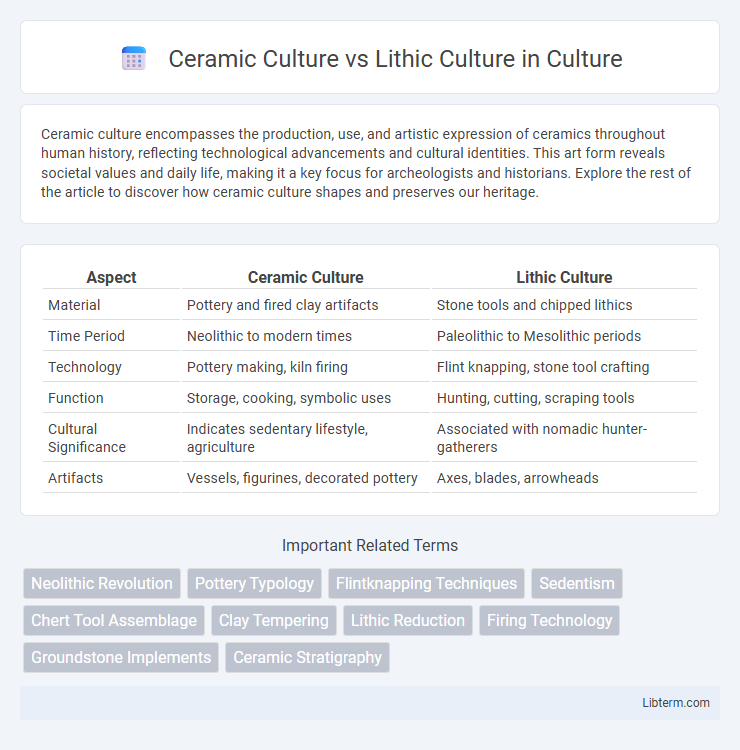Ceramic culture encompasses the production, use, and artistic expression of ceramics throughout human history, reflecting technological advancements and cultural identities. This art form reveals societal values and daily life, making it a key focus for archeologists and historians. Explore the rest of the article to discover how ceramic culture shapes and preserves our heritage.
Table of Comparison
| Aspect | Ceramic Culture | Lithic Culture |
|---|---|---|
| Material | Pottery and fired clay artifacts | Stone tools and chipped lithics |
| Time Period | Neolithic to modern times | Paleolithic to Mesolithic periods |
| Technology | Pottery making, kiln firing | Flint knapping, stone tool crafting |
| Function | Storage, cooking, symbolic uses | Hunting, cutting, scraping tools |
| Cultural Significance | Indicates sedentary lifestyle, agriculture | Associated with nomadic hunter-gatherers |
| Artifacts | Vessels, figurines, decorated pottery | Axes, blades, arrowheads |
Introduction to Ceramic and Lithic Cultures
Ceramic culture is characterized by the production and use of pottery, reflecting advancements in technology and social organization during the Neolithic era. Lithic culture revolves around stone tool manufacturing, essential for survival and development in prehistoric communities. Both cultures represent fundamental stages in human technological evolution, highlighting shifts in material usage and craftsmanship.
Defining Ceramic Culture: Key Characteristics
Ceramic Culture is defined by the widespread use of pottery characterized by advanced techniques in clay modeling, firing, and decoration, indicating complex societal and artistic development. Key characteristics include durable ceramic vessels used for storage, cooking, and ritual purposes, often decorated with symbolic motifs reflecting cultural beliefs. This culture also shows evidence of settled communities with agriculture and trade networks, contrasting with the predominantly tool-focused Lithic Culture.
Understanding Lithic Culture: Main Features
Lithic culture is characterized by the extensive use of stone tools and weapons, reflecting early human technological development during the Paleolithic and Mesolithic periods. Key features include the production of flaked and ground stone implements, reliance on hunting and gathering subsistence strategies, and the use of fire for cooking and tool-making. This culture's archaeological record reveals significant advancements in craftsmanship and adaptation to diverse environments before the widespread adoption of ceramics.
Historical Timeline: Ceramics vs Lithics
Lithic culture, characterized by stone tool use, dates back to the Paleolithic era, beginning approximately 2.5 million years ago and spanning until around 10,000 BCE, marking humanity's earliest technological phase. Ceramic culture emerged much later during the Neolithic period, around 9,000 BCE, coinciding with the advent of agriculture and sedentary societies, facilitating food storage and cooking. The transition from lithic to ceramic technologies reflects significant cultural evolution, with ceramics symbolizing advancements in craftsmanship, social organization, and economic complexity over time.
Technological Innovations: Pottery vs Stone Tools
Ceramic Culture is distinguished by the technological innovation of pottery, showcasing advanced techniques in clay shaping, firing, and decoration that enabled food storage, cooking, and cultural expression. Lithic Culture, on the other hand, centers on the development and refinement of stone tools, including flint knapping and blade production, which enhanced hunting, processing, and daily survival tasks. The shift from lithic to ceramic technologies marks a significant transformation in human societies, reflecting changing needs and advances in material manipulation.
Societal Impact and Daily Life
Ceramic culture revolutionized societal organization by introducing permanent settlements and surplus food storage, fostering complex social hierarchies and trade networks. In contrast, lithic cultures, relying on stone tools and a nomadic lifestyle, maintained smaller, more egalitarian groups with limited social stratification. Daily life in ceramic societies featured specialized crafts and communal rituals linked to pottery production, while lithic culture emphasized mobility, hunting, and gathering tasks essential for survival.
Artistic Expressions in Ceramic and Lithic Cultures
Ceramic culture showcases intricate pottery adorned with painted motifs, sculptural forms, and symbolic designs that reveal social and spiritual meanings. Lithic culture emphasizes stone tools and engraved objects, where artistic expression is evident in petroglyphs, carvings, and finely crafted implements reflecting technological skill and cultural identity. The contrast between colorful ceramics and monochromatic lithic artifacts highlights diverse mediums through which ancient communities communicated aesthetics and beliefs.
Archaeological Discoveries and Evidence
Archaeological discoveries reveal Ceramic Culture through advanced pottery shards, kiln remains, and decorative styles dated to the Neolithic period, indicating settled agricultural communities. Lithic Culture is identified by stone tools, flint flakes, and weaponry from the Paleolithic and Mesolithic eras, highlighting a hunter-gatherer lifestyle. Evidence from excavation sites like Catalhoyuk for ceramics and Olduvai Gorge for lithic tools underscores technological and social evolution in prehistoric human societies.
Cultural Transition: From Lithic to Ceramic Ages
The cultural transition from the Lithic to Ceramic Ages marks a pivotal shift characterized by the adoption of pottery and sedentary lifestyles, fundamentally altering human social organization and technology. During the Lithic period, societies relied primarily on stone tools and hunting-gathering subsistence, whereas the Ceramic Age introduced advanced craftsmanship, agriculture, and permanent settlements. This transition reflects significant cognitive and cultural developments, fostering greater food storage capabilities and complex community structures.
Legacy and Influence on Modern Societies
Ceramic Culture revolutionized artistic expression and technological advancement, leaving a lasting legacy in pottery, architecture, and ritual practices that shape modern aesthetics and cultural rituals worldwide. Lithic Culture, characterized by stone tool innovation, laid the foundational skills for human survival, influencing contemporary craftsmanship, archaeology, and our understanding of early human behavior. Together, these cultures contribute critical insights into human development, informing disciplines like anthropology, art history, and material science.
Ceramic Culture Infographic

 libterm.com
libterm.com